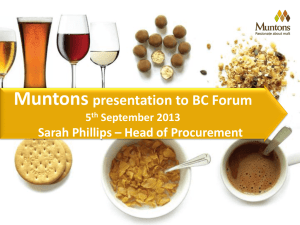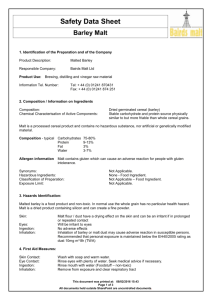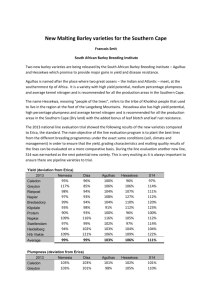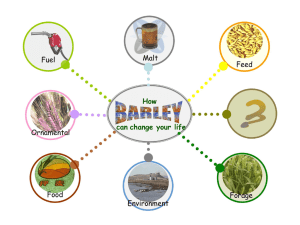SSR profile survey of winter and spring barley compared to malt
advertisement
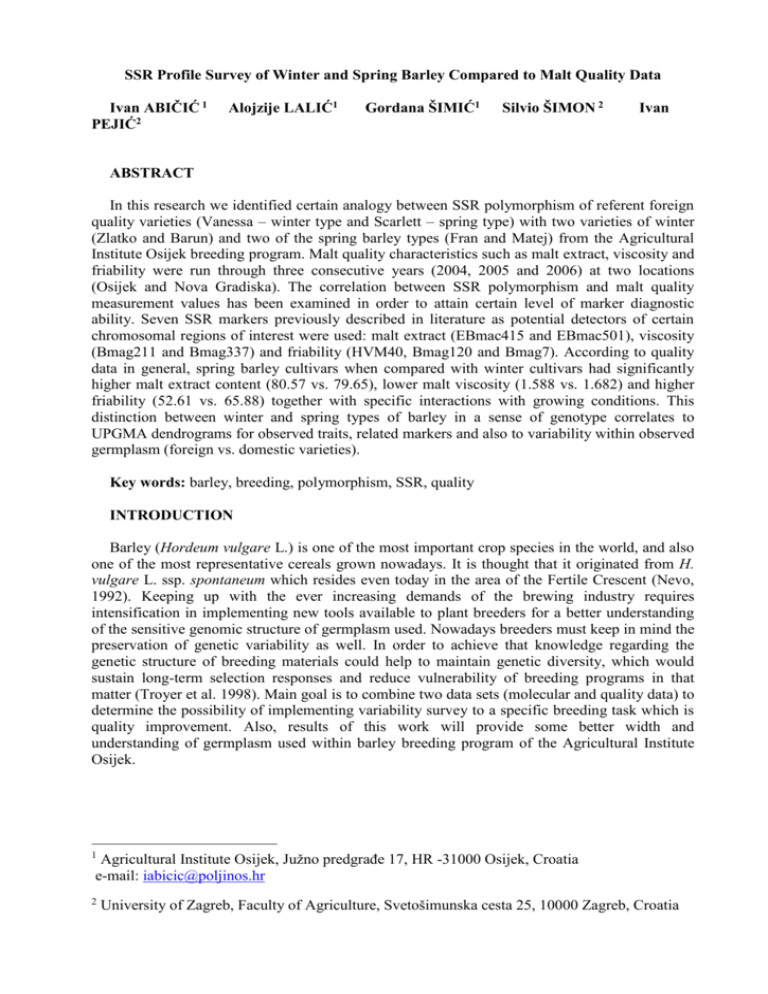
SSR Profile Survey of Winter and Spring Barley Compared to Malt Quality Data Ivan ABIČIĆ 1 PEJIĆ2 Alojzije LALIĆ1 Gordana ŠIMIĆ1 Silvio ŠIMON 2 Ivan ABSTRACT In this research we identified certain analogy between SSR polymorphism of referent foreign quality varieties (Vanessa – winter type and Scarlett – spring type) with two varieties of winter (Zlatko and Barun) and two of the spring barley types (Fran and Matej) from the Agricultural Institute Osijek breeding program. Malt quality characteristics such as malt extract, viscosity and friability were run through three consecutive years (2004, 2005 and 2006) at two locations (Osijek and Nova Gradiska). The correlation between SSR polymorphism and malt quality measurement values has been examined in order to attain certain level of marker diagnostic ability. Seven SSR markers previously described in literature as potential detectors of certain chromosomal regions of interest were used: malt extract (EBmac415 and EBmac501), viscosity (Bmag211 and Bmag337) and friability (HVM40, Bmag120 and Bmag7). According to quality data in general, spring barley cultivars when compared with winter cultivars had significantly higher malt extract content (80.57 vs. 79.65), lower malt viscosity (1.588 vs. 1.682) and higher friability (52.61 vs. 65.88) together with specific interactions with growing conditions. This distinction between winter and spring types of barley in a sense of genotype correlates to UPGMA dendrograms for observed traits, related markers and also to variability within observed germplasm (foreign vs. domestic varieties). Key words: barley, breeding, polymorphism, SSR, quality INTRODUCTION Barley (Hordeum vulgare L.) is one of the most important crop species in the world, and also one of the most representative cereals grown nowadays. It is thought that it originated from H. vulgare L. ssp. spontaneum which resides even today in the area of the Fertile Crescent (Nevo, 1992). Keeping up with the ever increasing demands of the brewing industry requires intensification in implementing new tools available to plant breeders for a better understanding of the sensitive genomic structure of germplasm used. Nowadays breeders must keep in mind the preservation of genetic variability as well. In order to achieve that knowledge regarding the genetic structure of breeding materials could help to maintain genetic diversity, which would sustain long-term selection responses and reduce vulnerability of breeding programs in that matter (Troyer et al. 1998). Main goal is to combine two data sets (molecular and quality data) to determine the possibility of implementing variability survey to a specific breeding task which is quality improvement. Also, results of this work will provide some better width and understanding of germplasm used within barley breeding program of the Agricultural Institute Osijek. Agricultural Institute Osijek, Južno predgrađe 17, HR -31000 Osijek, Croatia e-mail: iabicic@poljinos.hr 1 2 University of Zagreb, Faculty of Agriculture, Svetošimunska cesta 25, 10000 Zagreb, Croatia MATERIAL and METHODS Plant material consists of two referent and also foreign barley varieties known for their high quality (Vanessa – winter type and Scarlett – spring type; bred by Saatzucht Josef Breun, GDBR-Herzogenaurach, Germany) as well as two varieties of winter (Zlatko and Barun) and two of the spring barley types (Fran and Matej) descended from the Agricultural Institute Osijek breeding program grown through three consecutive years (2004, 2005 and 2006) on two locations (Osijek (45°31’54 N, 18°45’18 E) and Nova Gradiska (45°14’0 N, 17°20’21 E)), on two soil types, alluvium and eutric cambisol, respectively. Trial setting was arranged as randomized block design with four replications. Laboratory quality data was determined according to Analitica EBC (1998) for extract (method 4.5.1), viscosity (method 4.8) and friability (method 4.15). DNA was isolated by CTAB method (Doyle and Doyle, 1990) from leaf tissue grown from three seeds (for every sample/cultivar) sown into plastic container filled with substrate. Before DNA isolation, the tissue needed to be lyophilized and grounded with steel beads in order to get powdery texture of the sample. After isolation the concentration of genome DNA was determined by spectrophotometer. Amplification process (PCR reaction in Veriti Thermal Cycler, Applied Biosystems, U.S.A.) of microsatellite markers was carried according to Liu et al. (1996) and Li et al. (2003). PCR products were then being analyzed with genetic analyzer (ABI 3130 - size standard used: GeneScan 500LIZ, Applied Biosystems, U.S.A.) and data was retrieved via GeneMapper 4.0 (Applied Biosystems) software. Seven SSR markers previously described in literature as potential detectors of certain chromosomal regions of interest were used: malt extract (EBmac415 and EBmac501 – Mei et al., 2012), viscosity (Bmag211 and Bmag337 – Raman et al., 2003; von Korff et al., 2008) and friability (HVM40, Bmag007, Bmag120 – Li et al., 2005). Two-way approach for data analysis considered the use of different software. Firstly, the laboratory data for quality were processed via cluster analysis (Everitt, 1980). Also the differences between varieties and environments were tested with LSD-test and Duncan`s Multiple Range test. Dendrograms were formed to estimate and display the leveling of groups between varieties for extract and viscosity. Method of “Hierarchic Tree Clustering” was used to graphically point out different groups (clusters) via dendrograms. Ward`s minimum variance method was used to estimate the distance between clusters. Software used: IRRISTAT 5.0, IRRI of Manila (Irristat for Windows ©, 2005), for cluster analysis and dendrogram visualization. Secondly, SSR profile data also underwent variability analysis together with calculation of the phylogenic tree. Software used: POWERMARKER 3.25 (Liu and Muse, 2005) software and tree visuals formed by TREEVIEW 1.6.6. (Page, 2001). Main idea is to compare dendrogram data from two distinct sources to determine if those will show certain congruencies and to what extent. RESULTS The results of extract content and cytolytic degradation showed significant differences among cultivars of winter and spring type together with the year of cultivation. But as far as the results from locations are concerned there was no evidence which would point out the statistically significant difference towards extract content together with malt cytolytic degradation parameters. The significant (P≥0.05) results of the largest extract content and with best malt cytolytic degradation points to variety Scarlett. This variety is being followed by Fran (also spring type) and Vanessa (winter type). In general (tab. 1) spring barley varieties had higher amount of extract (80.57 vs. 79.64), lower malt viscosity (1.588 vs. 1.682) and higher friability (52.61 vs. 65.88) in GxE correlation in comparison to winter types. Table 1. Means for extract fine grind, friability and malt viscosity for 6 barley varieties at two localities in three years Variety/ Malt Extract, % Friability Year / viscosity Location/ Seasonal type Zlatko 79.13 b 47.53 c 1.788 a Barun 79.73 b 50.03 c 1.700 a Vanessa 80.07 ab 60.27 b 1.559 b Fran 80.62 ab 71.62 a 1.552 b Matej 80.42 ab 55.62 bc 1.700 a Scarlett 81.32 a 70.42 a 1.512 b LSD 0.05 1.57 9.80 0.129 2004. 79.04 c 51.58 b 1.709 a 2005. 79.89 b 59.16 ab 1.560 c 2006. 81.38 a 67.00 a 1.636 b LSD 0.05 0.75 8.83 0.072 Osijek 80.38 61.43 1.668 Nova Gradiska 79.83 57.07 1.602 LSD 0.05 ns ns ns Winter barley 79.64 b 52.61 b 1.682 a Spring barley 80.57 a 65.88 a 1.588 b LSD 0.05 0.91 16.36 0.074 Average 80.11 59.25 1.635 “a...c” - Duncan’s Multiple Range Test at P≤0,05 Figure 1. Extract content (Ward) Figure 2. Malt viscosity (Ward) Two distinct groups reveal themselves when we form a dendrogram for extract content, the spring types in one group and winter types in the other. Malt viscosity shows different display of dominant varieties, where all of the varieties tested did not show a specific grouping profile dependant solely on the fact what seasonal type varieties belong to. Nevertheless, combination of the data (fig. 1 and 2) reveals a group of higher malt quality varieties formed by Scarlett, Fran and Matej (spring) and Vanessa (winter). VANESSA SCARLETT FRAN BARUN MATEJ ZLATKO SCARLETT FRAN BARUN VANESSA 0.1 MATEJ Figure 3. Extract content via UPGMA (SharedAllele) 0.1 ZLATKO Figure 4. Malt viscosity via UPGMA (SharedAllele) Slightly different results occur in dendrograms formed solely on SSR polymorphic data. Certain crucial points could be made considering a number of the distinctly formed groups. Profiles connected to specified parameters observed, show us a constant in formation of the groups with clear distinction between winter and spring types of barley (fig. 3, 4, 5). The UPGMA dendrogram for extract accurately depicts the results obtained in tab. 1 by forming a single group of Fran, Vanessa and Matej which also show the similar reaction/result for this trait. Varieties Scarlett and Vanessa each belong to different seasonal types of barley (spring vs. winter) and this could be seen through all dendrograms. These varieties (Scarlett and Vanessa) also distinct themselves according to general variability, which is an expected result and something that represents a control mechanism of varieties, as well as, a starting point for further analysis (foreign vs. domestic) (fig. 6). These two referent varieties are of the foreign descent (country of origin is Germany). There is logic in the grouping process where Barun and Zlatko group together while Fran and Matej form a distinct group, all together (fig. 6). The same reaction/result could also be seen according to friability parameter where (on the higher level of joining) we can attach Scarlett and Vanessa as a subgroup to the group formed by Fran and Matej which also matches the laboratory data (fig. 5, tab. 1). The demands of brewing industry considering friability levels, state the need for no less than 70% in friability value and only Fran and Scarlett possess such values (tab. 1). 0.1 BARUN SCARLETT ZLATKO BARUN SCARLETT ZLATKO VANESSA VANESSA FRAN FRAN MATEJ 0.1 MATEJ Figure 5. Friability via UPGMA (SharedAllele) Figure 6. General variability – all markers included via UPGMA (SharedAllele) DISCUSSION Laboratory data suggest a range of value variation in extract difference, as well as the average values of year and location for this parameter. This trait is influenced to a significant extent by agronomic conditions during vegetation, meaning climate and soil. Parallel analysis based on homogenous groups points out similarities that may be useful while recommending for new varieties, because it is possible to determine similarities and differences from standardized and confirmed varieties, and in addition it is possible to assume reactions of these new varieties under production and specific cultivation conditions. Spring barley in general sense shows better results as far as the malt quality is concerned. This has been corroborated by Lalić and Kovačević, (1997) who point out that spring barley grown in the Republic of Croatia has the overall better and more stable results concerning quality of malt over winter types. SSR markers used for screening of the barley cultivars are able to determine the potential carriers of desirable traits, and the data shown in this paper confirm this on the level of variability study. This is due to various literature statements and scientific papers published and noted here. Area for examination of QTL’s for quality concentrates mainly around chromosome 1H. Regions on chromosome 1H are well known for their associations with malt extract and other malting attributes (Marquez-Cedillo et al. 2000; Collins et al. 2003). Also, the effect for other traits, meaning viscosity and friability are highly correlated to other ways of cytolitic and proteolitic disintegration of malt. Another way of trait improvement was set out by Von Korff et al. (2008) who state that as viscosity and friability are mainly affected by the breakdown of βglucan and other cell wall polysaccharides, genes affecting β-glucan or β-glucanase activity may also underlie QTL’s detected for mentioned traits. This fact opens another approach in detecting genes, QTL’s and/or alleles which post as carriers of traits for better enzymatic activity. In a sense it is possible to make selection by a two way approach improving both viscosity and friability on one hand and enzymatic activity on the other (cumulative effect) by selection process. Method described in this paper (genetic screening and comparison of data) could provide the basis for this type of problem solving. CONCLUSION Integration of molecular and quality data is possible to some extent and genetic data is satisfactory in terms that it explains the genetic background and variability of examined varieties well. On this level of data analysis this method is limited because of relatively small number of varieties examined but more importantly it is the small number of SSR markers that represents a restrictive factor for better and more precise genetic data resolution. The point is to improve the method by inclusion of more SSR markers (linked to QTL’s of interest) into genetic profile exploration of the germplasm concerned. In that way it will be possible to determine and display groups of elite barley lines which carry QTL’s for traits of interest (in this case quality traits) in a more precise manner. That way a set of “quality SSR markers” can be determined which will be useful for DNA screening of future progeny after the cross of previously screened parental lines. REFERENCES Analytica EBC V. (1998) Fachverlag Hans Carl, Nürnberg Collins H. M., Panozzo J. F., Logue S. J., Jefferies S. P., Barr A. R. (2003) Mapping and validation of chromosome regions associated with high malt extract in barley (Hordeum vulgare L.). Australian journal of agricultural research Vol. 54: 11-12 Doyle J.J. and J.L. Doyle (1990): Isolation of plant DNA from fresh tissue. Focus 12:13-15. Everitt B. (1980) Cluster analysis. London, Heinemann educational books. IRRISTAT for Windows © (2005), Version 5.0. International Rice Research Institute DAPO Box 7777, Metro Manilla, Phillipines. Korff (von) M., H. Wang, J. Leon, K. Pillen (2008) AB-QTL analysis in spring barley: III. Identification of exotic alleles for the improvement of malting quality in spring barley (H. vulgare ssp. spontaneum). Mol. Breeding Vol. 21: 81–93 Lalić A., Kovačević J. (1997) Oplemenjivanje ječma za potrebe sladarstva i stočarstva u Republici Hrvatskoj. Poljoprivreda , 3 (2): 31-45 Li J. Z., X. Q. Huang, F. Heinrichs, M. W. Ganal M. S. Roder (2005) Analysis of QTLs for yield, yield components, and malting quality in a BC3-DH population of spring barley. Theor. Appl. Genet. Vol. 110: 356–363 Li J. Z., T. G. Sjakste, M. S. Roder, M. W. (2003) Ganal Development and genetic mapping of 127 new microsatellite markers in barley. Theor Appl Genet 107: 1021–1027 Liu K. and S. V. Muse (2005) POWERMARKER: Integrated analysis environment for genetic marker data. Bioinformatics 21(9): 2128 - 2129 Liu Z. W., Biyashev R. M., Saghai Maroof MA (1996) Development of simple sequence repeat DNA markers and their integration into a barley linkage map. Theor Appl Genet 93: 869–876 Marquez-Cedillo L. A., P. M. Hayes, B. L. Jones, A. Kleinhofs, W. G. Legge, B. G. Rossnagel, Sato K., S. E. Ullrich, D. M. Wesenberg and North American Barley Genome Mapping Project (2000) QTL analysis of malting quality in barley based on the doubled-haploid progeny of two elite North American varieties representing different germplasm groups. Theoretical and Applied Genetics Vol. 101, Nr. 1-2: 173-184 Mei L., Ping J., Wang D., Zhang Z., Luo S., et al. (2012) Malt Genotypic Screening of Polymorphism Information Content (PIC) of SSR Markers Based on Physiological Traits in Barley. Mol Biol 1:101. doi: 10.4712/2168-9547-1-101 Nevo E. (1992) Origin, evolution, population genetics and resources for breeding of wild barley, (Horedum spontaneum) in the Fertile Crescent. Barley: Genetics, biochemistry, molecular biology and biotechnology. Edited by Peter Shewry CAB International Press, London. pp. 1943. Page R. D. M. (2001) TREEVIEW 1.6.6 Raman H, Venkatanagappa S, Rehman A, O’Bree B, and Read B (2003). Graphical genotyping of barley using molecular markers linked with malting quality, disease resistance and aluminium tolerance. Proceedings of 11th Australian Barley Technical Symposium, Adelaide, pp 246-249. Troyer A.F., Openshaw, S.J., and Knittle, K.H. (1998): Measurement of genetic diversity among popular commercial corn hybrids. Crop Sci. 28: 481–485.
